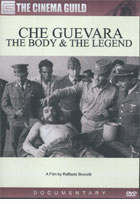
Che Guevara: The Body and The Legend 2007
Distributed by Cinema Guild, 115 West 30th Street, Suite 800, New York, NY 10001; 212-685-6242
Produced by B& B Films
Directed by Raffaele Brunetti
DVD, color, 52 min.
College - Adult
Latin American Studies, International Relations, Popular Culture
Date Entered: 03/07/2008
Reviewed by Charmaine Henriques, Northwestern University Library, Evanston, ILAlong with Fidel Castro he was the architect of the Cuban Revolution, and later the Minister of Industry and the President of the National Bank. But, in March of 1965 he abandoned everything and went underground to join liberation movements in Africa and South America. Two years later in the summer of 1967 the CIA discovered he had entered Bolivia in disguise using false documents and was leading guerillas against government forces. Three months later Ernesto “Che” Guevara was dead.
The Bolivian army was unprepared when they captured Che Guevara on October 8, 1967. Bolivian officials wanted him dead, but it was complicated. The word was put out that Che was supposed to die in combat. Unfortunately, the whole entire town of La Higuera had already seen him very much alive when he was transported to a school house in the village. Nevertheless, this did not matter; a noncommissioned officer, Mario Teran carried out the mandate to kill Che.
By October 10, 1967 one of the greatest spectacles of the 20th century took place when Che’s dead body was transported to the nearby town of Vallegrande. At the age of 39, Che Guevara lay dead on a cot in a concrete room while the residents of Vallegrande were paraded before him and the international press took photographs of the cadaver, providing world proof of his demise. After that event, his body would vanish and nobody would be allowed to look for it for another 30 years. While the Bolivian government tried to portray Che as a crazy man who tried to take on the world, failed horribly, and was punished by death; they did not realize that hiding the corpse and lying about the circumstances of his death would only enhance the legend of Che and in time the image of the Bolivian army would change from victors to assassins. In 1997, Che Guevara’s remains were identified and found in an abandoned airstrip in Vallegrande by a team of Cuban and Argentine forensic anthropologists. He was given a hero’s welcome and buried in state in Cuba.
This 50 minute documentary shows how throughout the years the power of Che’s legend is strong as ever, but also examines the commercialization of his iconic image, which conflicts with his beliefs. Black and white photographs and historic footage along with interviews from journalists, residents of Vallegrande, one of Che’s comrades, forensic anthropologists, and former members of the Bolivian military help paint the picture of his passing and answers questions about the conspiracy of his death and why close to the end of his life he turned a critical eye towards his former allies the Soviet Union. The biggest drawback of the documentary is while the conspiracy of Che’s death and the search for his remains are covered very well, nothing new or ground breaking is presented. Furthermore, there is absolutely no mention of his earlier life. I would recommend this documentary for beginning students/scholars in Latin American history, Inter-American relations, and those interested in Che Guevara or the Cuban revolution and its aftermath.